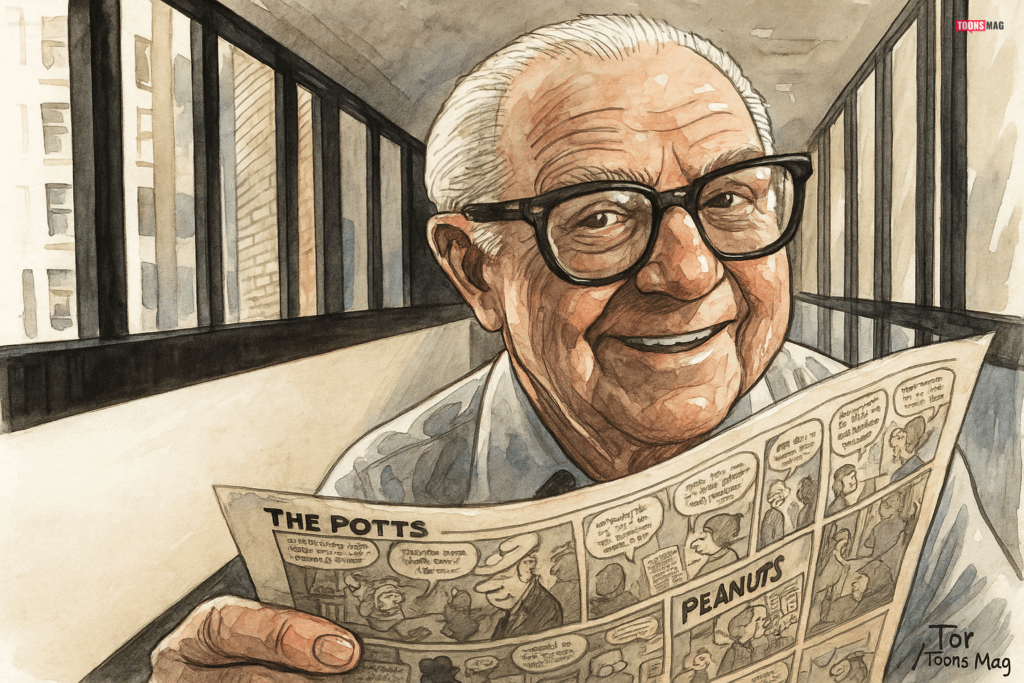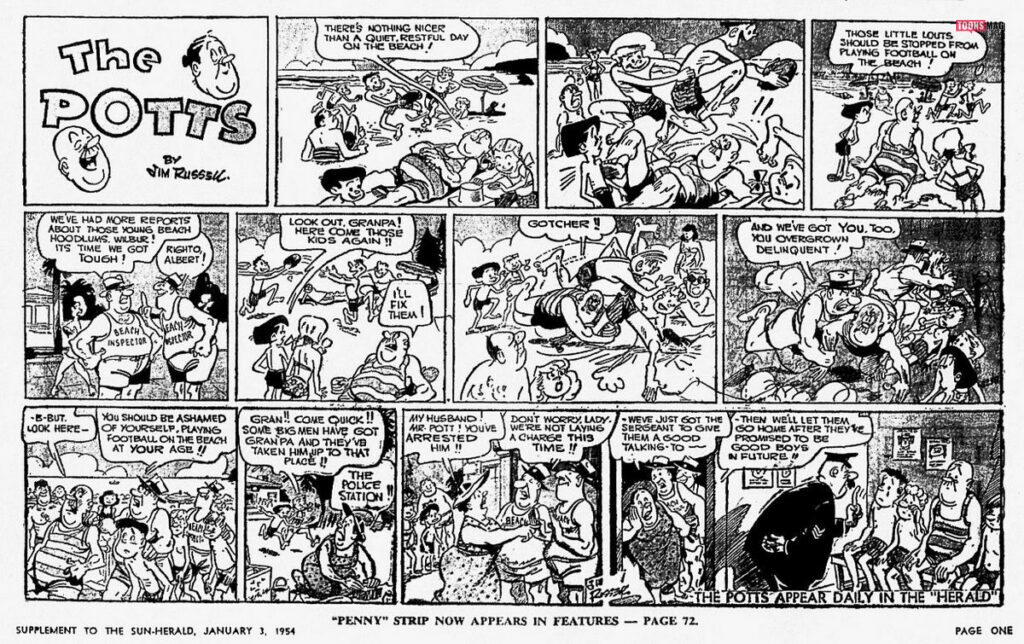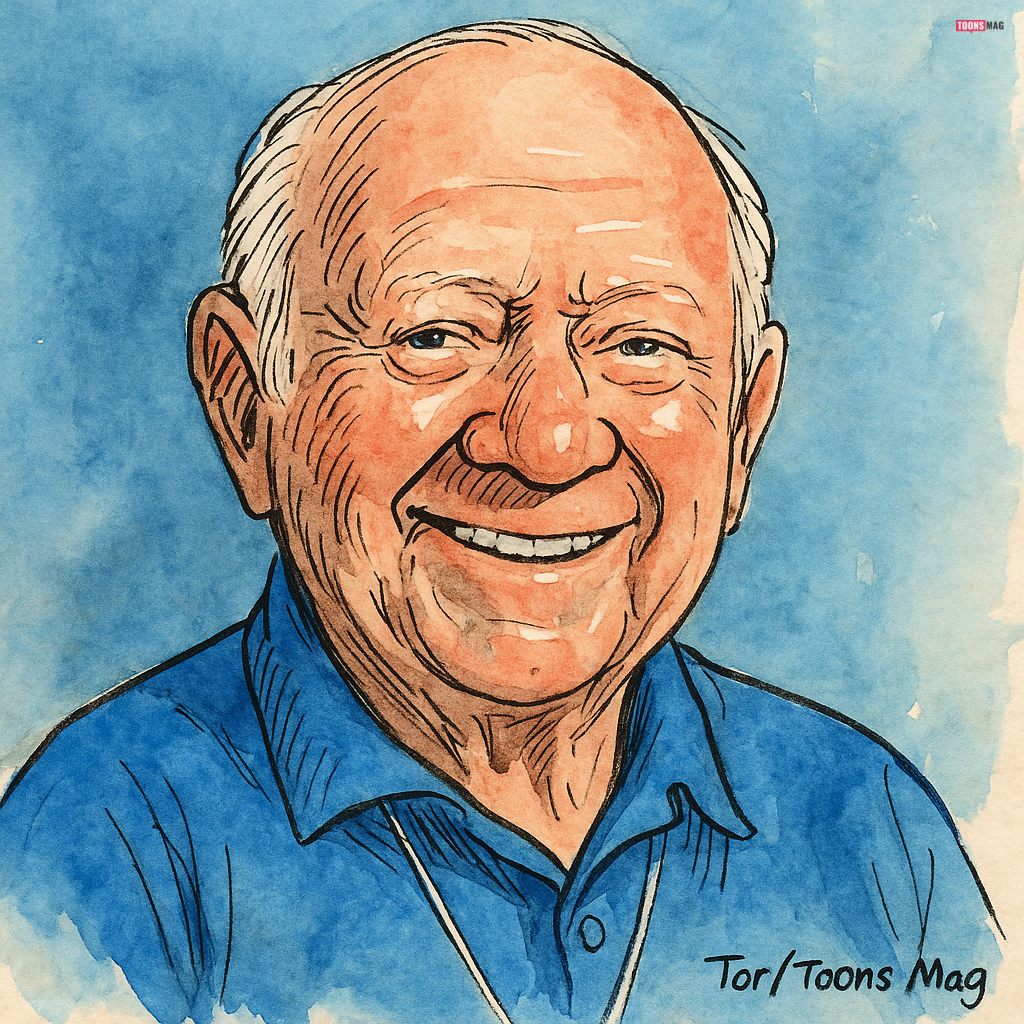Jim Russell, born James Newton Russell AM MBE (26 March 1909 – 15 August 2001), was an iconic Australian cartoonist, celebrated for his unparalleled contribution to the comic arts and his record-breaking 62-year continuous authorship of the beloved comic strip The Potts. Revered for his longevity, prolific output, and dedication to nurturing the cartooning community, Russell’s legacy is one of creativity, innovation, mentorship, and national pride. He earned a place in the Guinness Book of Records as the world’s longest-running solo cartoonist, surpassing other industry legends.
Infobox: Jim Russell
| Attribute | Details |
|---|---|
| Full Name | James Newton Russell |
| Birth Date | 26 March 1909 |
| Birth Place | Campsie, New South Wales, Australia |
| Death Date | 15 August 2001 (aged 92) |
| Death Place | Sylvania, New South Wales, Australia |
| Occupation | Cartoonist, Illustrator, Publisher, Broadcaster |
| Notable Work | The Potts, Mr. and Mrs. Pott, Adolf, Herman and Musso, Schmit der Sphy |
| Other Pen Name | Mick Newton |
| Years Active | 1920s – 2001 |
| Honors | AM, MBE, Guinness World Record holder |
| Organizations | Black and White Artists’ Club, US National Cartoonists Society |
Early Life and Education
Jim Russell was born in Campsie, NSW, into a politically active and progressive family that instilled in him a sense of public service and creativity from an early age. His father, William John “Billy” Russell, was not only a respected union leader and president of the New South Wales Plumbers’ Union, but also an advocate for workers’ rights at the national level.
Tragically, Billy died in a workplace accident in 1915, an event that deeply shaped Jim’s perspective on social justice and the importance of perseverance. His mother, Catherine Elizabeth Russell, went on to remarry and achieve her own place in Australian history as one of the first women to serve in an Upper House of Parliament—a milestone that underscored the progressive values of the Russell household.
Jim’s formative education took place at Tempe Technical School and Christian Brothers’ High School in Lewisham, where he began to nurture his passion for drawing. He demonstrated an early flair for caricature and satire, often sketching teachers and classmates in the margins of his notebooks. At just 14 years old, he left school to work as a copy boy for the Daily Guardian, where his enthusiasm for art quickly outpaced his clerical duties.
After being dismissed for spending too much time in the art room, Russell took a job at Smith’s Weekly, a move that would prove pivotal to his future. There, he worked under the tutelage of iconic cartoonist Stan Cross, absorbing the essentials of cartooning and publication design.

To hone his craft further, Russell studied for six years at the Julian Ashton Art School in Sydney, a prestigious institution that produced many of Australia’s great artists. During this period, he supported himself through an array of part-time jobs, including selling tickets at the Sydney Stadium and sketching portraits of boxing champions. His time at the stadium also saw him briefly enter the ring as a welterweight boxer, winning all five of his bouts—a testament to his grit and versatility. These eclectic experiences enriched his worldview and added depth to the humor and resilience that would later characterize his cartoons.
Cartooning Career and Rise to Fame
Breaking into the Industry
Russell became Australia’s youngest political cartoonist in 1928 at just 19 years old, when he was hired to draw for the Sunday News. This early role marked the beginning of a prolific career, as his cartoons quickly gained recognition for their sharp wit and keen observations of political and social life. His work often addressed both national and international affairs, using satire to critique political decisions, social injustices, and public figures.
After the Sunday News folded in 1931, Russell joined The Referee as a sports caricaturist, where he expanded his range to include illustrations of athletes and sporting events. Soon after, he returned to Smith’s Weekly, this time as a fully fledged cartoonist. It was here that his career truly took off. By 1933, Russell was a household name across Australia, known for his bold lines, humorous insights, and the consistency of his daily cartoons. His ability to connect with a wide readership made him one of the most beloved media figures of his time, and he continued to shape public discourse through his illustrations for decades to come.
The Potts: A National Institution
In 1940, Russell inherited the comic strip You and Me from Stan Cross and transformed it into Mr. and Mrs. Pott, which later evolved into The Potts. What began as a quirky domestic satire quickly developed into a richly layered comic strip reflecting Australian suburban life through humor, caricature, and relatable family dynamics. Russell introduced a cast of eccentric yet endearing characters who resonated with readers from all walks of life.

One of the most impactful additions was Uncle Dick, a mischievous, boisterous relative who brought an element of unfiltered candor and comic absurdity. Originally introduced as a temporary addition to bypass editorial constraints on edgier content, Uncle Dick’s rogue behavior and blunt commentary struck a chord with audiences, making him a permanent fixture and often the strip’s comic focal point. Through decades of cultural and political change, The Potts maintained its popularity by adapting to the times while preserving its quintessential Australian humor and warmth. The strip’s longevity and evolving cast helped solidify its status as a cultural mainstay both in Australia and internationally.
War Satire and National Recognition
During World War II, Russell created satirical comic strips such as Adolf, Hermann and Musso and Schmit der Sphy, sharply lampooning Axis leaders including Adolf Hitler, Hermann Göring, and Benito Mussolini. These strips reflected the public’s disdain for fascist ideologies and became a source of comic relief and patriotic morale for Australian readers during a tumultuous time. His incisive humor and vivid caricatures not only entertained but also played a critical role in wartime propaganda, reinforcing the values of resilience and unity.
Russell’s artistic contributions were widely acclaimed, culminating in his receipt of 1st prize in the National Gallery of Victoria’s prestigious 1945 “Australia at War” exhibition—an honor that highlighted the significant impact of his work in bolstering national identity and cultural resilience during the war years.
Publishing Ventures and Diversification
All-Australian Comics
In 1947, Jim and his brother Dan Russell founded All-Australian Comics, a pioneering publishing company aimed at creating uniquely Australian comic content during a time when imported comics dominated the local market. They launched several titles including Tex Morton’s Wild West Comics, which featured the real-life country music star Tex Morton in fictionalized adventures with his mates Jacky, Shorty, and Slim. These comics merged Australian outback charm with the high-action tropes of American Westerns, creating a style that resonated strongly with younger audiences. In addition, Kanga’s K.O. Comics introduced new action-packed characters and storylines that celebrated Australian culture and landscapes.
Jim Russell, under the pseudonym Mick Newton, also contributed to the burgeoning library of titles with Wanda Dare, a bold and trailblazing female reporter who frequently found herself in the midst of thrilling mysteries and political intrigue. The inclusion of a strong female protagonist was groundbreaking for the time and showcased Russell’s forward-thinking approach to character development.
All-Australian Comics enjoyed initial commercial success and built a dedicated readership, but the company ultimately folded in 1950 due to rising production costs and the re-entry of American comics into the Australian market. Despite its brief lifespan, the venture left a lasting impact on the national comic scene and demonstrated Jim and Dan Russell’s commitment to telling homegrown stories with universal appeal.
Though successful initially, the venture folded in 1950 due to rising production costs and competition from imported comics. Nevertheless, it established Jim and Dan as pioneers in Australian comic publishing.
Record-Breaking Longevity and Global Recognition
Russell resumed The Potts in 1950 under the Melbourne Herald after Smith’s Weekly folded. He continued drawing the strip daily for over 62 years, never employing an assistant. This feat earned him a Guinness World Record and placed him alongside cartooning legends such as Charles Schulz and Marc Sleen.
He was also a radio panelist, television personality, and film reviewer. His charisma and wit made him a favorite on The Pressure Pak Show and other programs. He authored books, wrote travel columns, and even founded multiple travel agencies.

Legacy, Mentorship, and Cultural Impact
Mentorship and Advocacy
Jim Russell was instrumental in promoting cartooning in Australia. In 1924, at just 15 years old, he co-founded the Australian Black and White Artists’ Club, an organization that became the cornerstone for cartoonists and illustrators in the country. He served as the Club’s president from 1955 to 1957 and again from 1965 to 1973, later becoming its patron and life member. His leadership helped the Club expand its influence, supporting exhibitions, professional development, and community events that highlighted the value of black-and-white art in Australia.
Beyond his formal roles, Russell was an ever-present mentor to countless young cartoonists, providing them with both professional guidance and personal encouragement. He actively scouted and nurtured new talent, opening doors for emerging artists in newspapers and publishing. Through speeches, workshops, and advocacy, he emphasized the importance of cartooning as a respected art form and medium for public discourse.
In recognition of his contributions, the Club’s Silver Stanley Award, initially given for outstanding services to black-and-white art, was renamed the Jim Russell Award. It remains one of the highest honors in Australian cartooning today, symbolizing the legacy of a man whose lifelong passion lifted an entire industry.
Global Impact
Russell was the first Australian to become a member of the United States National Cartoonists Society, a distinction that underscored his international stature and influence in the world of cartooning. His trailblazing membership opened doors for other Australian artists to gain recognition abroad. His iconic comic strip The Potts achieved significant global reach, being syndicated internationally and published in over 40 American newspapers during the 1960s. This widespread distribution not only introduced American audiences to Australian humor and storytelling but also solidified Australia’s cultural presence on the international comic stage. Russell’s success overseas helped elevate the status of Australian comics globally, demonstrating that Australian cartoonists could stand shoulder to shoulder with the best in the industry.
Later Years and Personal Life
Jim married Lillian “Billie” Brann in 1931, and the couple shared a long and devoted partnership that lasted over six decades. They had one daughter, Judith Aileen, who remained close to her parents throughout their lives. Billie was known for her quiet strength and supportive nature, often helping behind the scenes in Jim’s various ventures. Her unwavering support was a constant source of stability for Jim as he balanced his demanding professional commitments.
Billie passed away in 1995 after a prolonged illness, during which Jim demonstrated his deep devotion by visiting her twice daily without fail, despite his own aging and professional obligations. This period highlighted the depth of their bond and the compassion that characterized Jim’s personal life. His brother, Dan Russell, also a renowned cartoonist and his lifelong collaborator, passed away in 1999, marking the end of a significant familial chapter in Australian cartooning history.
Even into his 90s, Jim defied expectations of aging. He remained extraordinarily active and mentally sharp, continuing to travel widely and participate in professional events. He was regularly seen at industry gatherings, cartooning conventions, and was often a guest speaker, where his wit and anecdotes captivated audiences. He continued to draw every day, often juggling multiple projects.

In 2000, Jim carried the Olympic torch through the town of Aberdeen in the Hunter Valley, proudly participating in the relay for the Sydney Olympics. At the age of 91, he showcased remarkable energy and national pride, cheered on by locals who recognized his legacy. Around this time, he also played an instrumental role in organizing travel logistics for fellow cartoonists and journalists attending the Olympics, leveraging his experience from years of involvement in sporting administration and travel consultancy.
Russell passed away peacefully on 15 August 2001 at the age of 92. His death marked the conclusion of an extraordinary chapter in both cartooning and Australian cultural history. His funeral, held at Woronora Crematorium, drew an overflowing crowd that included fellow cartoonists, journalists, admirers, and industry peers. Many stood outside the chapel, listening through loudspeakers, a powerful reflection of the deep respect, affection, and inspiration he had cultivated over a lifetime.
Honors and Recognitions
- Member of the Order of the British Empire (MBE) – 1976
- Member of the Order of Australia (AM) – later date
- Silver Stanley Award – 1985 (now the Jim Russell Award)
- Guinness World Record – Longest-running comic strip drawn by a single artist
- US National Cartoonists Society – First Australian member
- Patron and Life Member – Black and White Artists’ Club
- Olympic Torchbearer – 2000 Sydney Olympics
Jim Russell was more than a cartoonist—he was a legend. His boundless energy, wit, and devotion to his craft spanned generations and inspired countless cartoonists worldwide. A true renaissance man, he bridged the worlds of comics, broadcasting, publishing, sport, and public service. Through The Potts and his other creative endeavors, he captured the heartbeat of Australian life with humor, insight, and enduring charm.
“He never stopped working or promoting cartooning.” — Lindsay Foyle
This post was created with our nice and easy submission form. Create your post!





Too much Getty image. The post doesn’t look like a professional. I think I can do the job better than her.